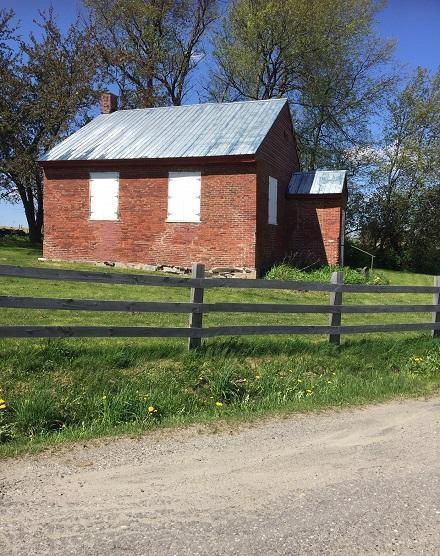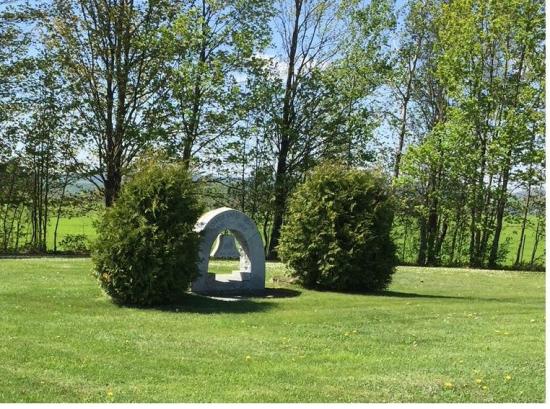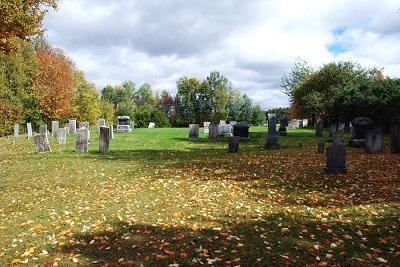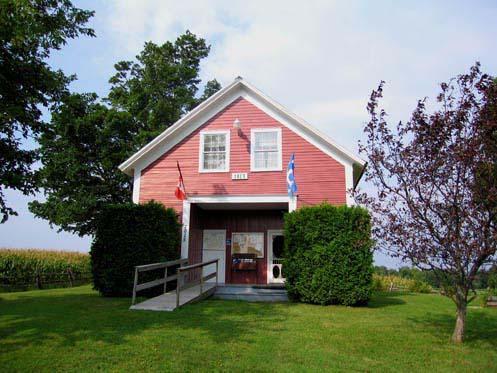The History of Stanstead East
From Déjeuner-causerie of April 11th , 2018 by Mr Gilbert Ferland, mayor of Stanstead-Est
The Municipality of Stanstead East is the farthest to the west of the Coaticook MRC and touches the Stanstead Town limit and the American border on the southern boundary. It has an area of 114 km2 , of which the municipality is crossed from north to south by two major roads, including the Route 143 highway and Autoroute 55. Eighty-nine kilometers of road are maintained by the municipality. The municipality has a population of 607 persons within this area.
Agriculture is as important in this area as the dairy, pork, poultry, cattle, goat, maple industry and forestry sectors are. We also find tree nurseries and field crops. Agro-tourism companies specialize in blueberries, raspberries, apples, honey, garlic and a large vegetable garden center, etc.
Also located here is a well known golf course with a splendid view of the area, a nature trail and a bike path much appreciated by those who use it. Part of this nature trail contains a bird sanctuary, a rare site in Quebec close to human actvity. More than one hundred species of birds can be found here. The endangered wood turtle is in the Tomifobia River area, a river that crosses much of Stanstead East. A small airport, many points of interest, shops, business ventures, etc. make Stanstead East a municipality to discover.
In the early 1800's, the territory was made up of four villages, namely Fairfax, Brown's Hill, Boynton, and Cassville. John Cass relates the story of Stanstead East in a text by Anne Dansereau, from the Coaticook Cultural Association. Note also the contribution of Mrs. Carole Chasse.
''I am honored to welcome you to Stanstead East, specifically to the village of Cassville. It was my uncles and my father, the Cass brothers, along with their friends the McClarys, Lockes, Libbys, etc. who cleared the beautiful farms that you see around here.
The pioneers of Cassville generally came from the village of Epsom, New Hampshire.
When they arrived in the early 1800's, the seven families lived together in the same cabin until each family was able to build their own home. They lived in log houses in those first years and their were no roads, no blacksmiths and no flour mills.
The nearest miller lived in Vermont. My Uncle Frank told me that he walked with his sack of grain through the woods to Fitch Bay, six miles from here in the direction of Owl's Head. At Lake Memphremagog he embarked in a canoe and paddled the twenty miles to Newport. All that just to bring back a bag of flour to Cassville! Finally, in 1805, Mr. Boynton, built a mill on the Tomifobia River.
The township grew quickly. In 1819, the year that I was born, their were scattered villages and a large church to the south about 3 miles from here. This was the first church in Stanstead.
A''Meeting House'' was available to everyone: the Congregationalists, the Methodists, and the Baptists. Cassville even had a school which was built in 1817.
The children learned to read in private homes before the school was built. As soon as there were about fifteen students in the neighborhood, the pioneers would organize a class. Reading was very inportant as it went hand in hand with religion. You had to know how to read in order to study the Bible.
It was here that I learned my alphabet. In 1830, I was eleven years old, and we were about sixty students in the Cassville School. One third of the students came from my family. There was my sister, my two brothers, and nineteen of my cousins! There were the children of my uncles, Thomas, Theophilus, Francis and Simon Cass. There were also the McClary cousins, Aunt Betsey's children. No need to tell you that I felt very much at home in the Cassville School.
We had very good teachers! Marietta Whitcher and her sister Mary Jane, the doctor's daughters. They had a home beside Curtis Road, not far from the church. Oh! This building held a lot of wonderful memories.

First school of Cassville
In the fall of 1842, the Adventists decided to camp in the church. Pastor Miller had announced the end of the world for the spring of 1843. The faithful brought all their provisions to the church, settled down and waited for the Apocalypse to take place. This, fortunately, did not happen.
Five years later, in 1848, this building was demolished and useable material from the site went into the building of a new church just a short distance from here at the corner of the Cassville Road. For us it was a convenience to have the church located nearby.
It was at this time that there was talk about a railroad project between Montreal and Portland, Maine. The business people in Stanstead wanted the track to pass through there, and with some luck they might win the project but, it was Coaticook that won the jackpot in 1853, and the train took another route on the other side of the county.
Mr. Colby, our deputy, was determined to have a railroad pass through this area. It took almost twenty years but finally on July 1, 1870 the Massawippi Valley Railroad passed through the Tomifobia valley. On that particular day, my wife Sabrina, my son George and daughter Edna...the whole family went down to Boynton to see this famous train.
The years that followed were difficult. In 1872, I lost my son George and three years after that, my Sabrina went to join him. I remarried and continued to work on the farm.
You know that with the coming of train service that markets were now opened up. Also, there was competition with many agricultural products being shipped in from far away. Several of the Cassville farmers decided to specialize in dairy production as an alternative to this situation. I found myself too old for the change. The future now belonged to a new generation of farmers.
I died at 85 years in 1904 at the dawn of a new century which would bring with it its own share of changes. In 1932, Stanstead Township was divided into two parts and the eastern part became a municipality. Stanstead East consists of the hamlets of Boynton, Cassville, Fairfax and a part of Brown's Hill where my Uncle Levi, the seventh of the Cass brothers, was established. One of these descendants, Melvin, founder of Cass Funeral Homes, which you may have heard about.
In 1966, they tore down our church near the Cassville Road. The following year Highway 55 was constructed and the road became a cul-de-sac. People now needed to make a big detour to get to Boynton.

United Church of Casseville
The train disappeared in the late 1980's. Today, the old right-of-way along the Tomifobia has become a nature trail, for people to walk or ride their bikes.
A great many changes have taken place over the years but the old Cassville School is still standing just like the little red brick school at the corner of Curtis road. If you go in that direction, you will see the Cassville Cemetery, near Grenier Road, where my family and I are buried.
I must say that it was really nice to talk about my area of the country and I hope you enjoy your own tour. ‘’
You can listen to a recording of this character at the old Cassville School which has since become the Stanstead East Town Hall.
Let us now take a closer look at the history of the little village of Cassville.
The village of Cassville was formed in 1799 by LEADER ASSOCIATE who brought a group of settlers from New England. These colonists, like most of their fellow countrymen, were believers in the Puritan teachings, which placed great importance on education. Part of the duty of this Protestant sect was to make sure their children knew how to read the Bible and understand the laws of the land. Since Cassville was such a small community, it needed only two institutions: a Methodist Church which was built in 1806 and later was to become the United Church in 1925, and a school which was built in 1817.

Casseville Cimetery
The church was demolished in 1966 leaving only the school house as a relic of the past. In 1817, in the village of Cassville, five families of the association have a total of twenty-six children. They wanted their children to receive an education and in this year some of the residents built a house which offered classes a few months each year. Today this building is used as the Town Hall by the Municipality of Stanstead East.

City Hall of Stantead East
During the first years, the school survived through student school fees and voluntary contributions from parents or guardians. In 1829, the adoption by the provincial parliament of the act for the encouragement of elementary education allows the government to grant subsidies to school boards in good standing whether they be Protestant or Catholic. On May 18, 1829 five administrators were elected who officially recognized the use of private schools starting May 19, 1829. At the end of the 1829 school year, eighteen schools in Stanstead Township request a grant application for their teachers. Only eleven of these schools, including the Cassville School, would receive the allowance of E20 (a shilling equals a dollar). In 1829, a teacher by the name of Almira Rogers was paid E2 monthly and given free lodging. In 1830, the school was integrated into the new school board system which included the twenty-two schools of the Towship for a total of one thousand and fifty-two students. Since most of the older students were required to work on the farm, most of the schools were only open during the winter months. The Cassville School was an exception with this schedule and offered a winter session along with a spring session.
In the early part of the 1850's, the number of students increased and academic standards improved which allowed the school to attain the status of academy. At this time the school received an annual government subsidy of E50 which covered the teachers' salaries and for the maintenance of the building.
With the arrival of the French Canadians in the Eastern Townshis, the Cassville Academy agreed to receive French speaking students in 1859. It thus became one of the first schools to provide education to the Catholic French in the Eastern Townships. However, as Inspector H. Hubbard did not buy any books in French, it is very likely that Mrs. William Heath's classes were only available in English. According to the Educational Journal of 1858, the number of students in Cassville stood at one hundred and five for that year. However, it seems the attendance records in schools were inflated at this time in order to receive larger grants. This would explain the sudden drop in attendance that appears in the official docuements three years later, in 1861, when only twenty-six students are recorded in the attendance records. Other explanations can also be seen in other schools closer to Stanstead and Hatley or from families moving on to larger cities like Sherbrooke to work in the mills.
From 1912 to 1941, schools would open and close until it was proposed by Aphonse Bouffard and seconded by Alfred Vachon (maternal grandfather of Gilbert Ferland, current mayor of Stanstead East), to unify Districts 3 and 4 to provide for enough families. It was finally decided in 1947 that the school was transferred to the Stanstead East Municipal Council to be used as a Town Hall. Maintenance over the years and major renovations in 2016 and 2017 have rejuvenated the 200 year old historic building.
This was a brief summary of like in the early 18th century.
It is important to note that the Hydro-Quebec dam at Burrough's Falls produced electricity for a hundred years. This dam served to drive the water from the reservoir to the generating station. A six foot wooden pipe was removed from the ground here in 2016.
It is important to note that Knight's Sanctuary is located on Curtis Road alongside the Tomifobia River. An exceptional area can be found here which includes a bike path and walking trail and an ornithologist's dream as their are more that one hundred species of birds recorded here.
Two veterans monuments were erected in 1920 near the Dufferin Heights Golf Club. One monument lists the combattants whe died in World War 1 and World War 11. The second monument lists the names of 96 pioneers.
The Dufferin Heights Golf Course is a high point in the area with an altitude of 1500 feet located where the chalet or restaurent is situated. Dufferin Heights was named after Lord Dufferin, Governor General of Canada from 1872 to 1878. Thanks to his visit in 1878, the name was bestowed. He and his entourage climbed to the summit and Lord Dufferin declared the view to be ''the most spectacular of any other place he had seen''.
This site was first claimed by David Morrill and his family who proceeded to clear the land in the early 1800's. The descendants of the Morrills still own about 10 acres on the height of the land. You will also be able to admire a bronze relief map of the entire region, created in 1927 by noted local sculptor, Orson Wheeler.
Here is, in summary, the history of the Municipality of Stanstead East.
From Déjeuner-causerie of April 11th , 2018 by Mr Gilbert Ferland, mayor of Stanstead-Est



